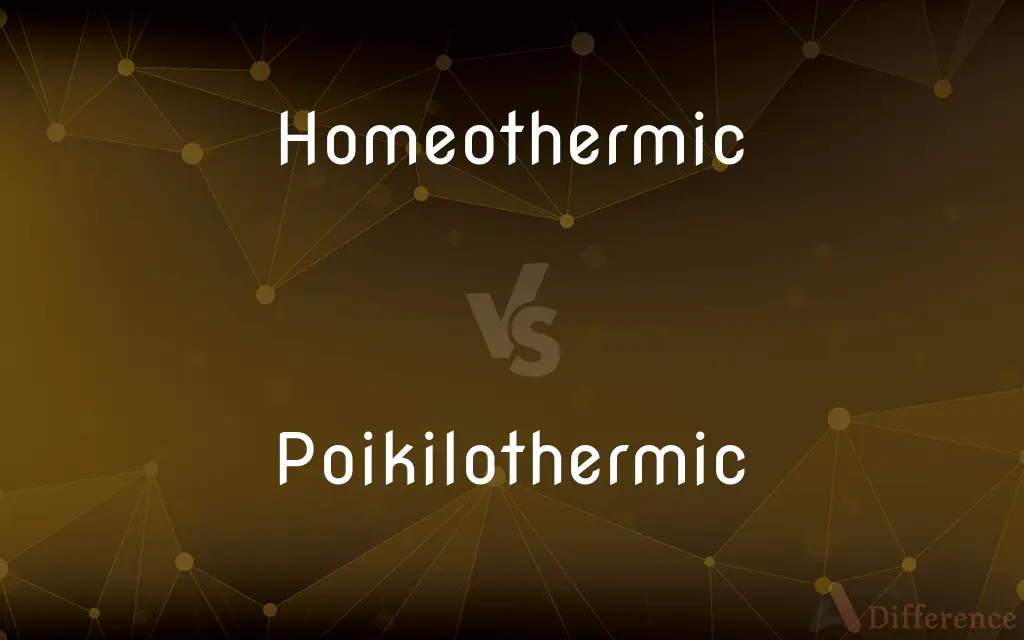Homeothermic vs. Poikilothermic — What's the Difference?
Edited by Tayyaba Rehman — By Fiza Rafique — Updated on March 14, 2024
Homeothermic animals maintain a constant body temperature regardless of environmental changes, while poikilothermic animals' body temperature varies with the ambient temperature.

Difference Between Homeothermic and Poikilothermic
Table of Contents
ADVERTISEMENT
Key Differences
Homeotherms, also known as endotherms, use metabolic processes to keep their internal temperature within a narrow range, ensuring optimal physiological functioning. Poikilotherms, or ectotherms, rely on external sources of heat to regulate their body temperature, making them more susceptible to environmental temperature fluctuations.
Homeothermic animals have adaptations like insulation and perspiration to maintain thermal balance, facilitating activity in various climates. Poikilothermic animals may exhibit behaviors such as basking in the sun or seeking shade to manage their body temperature, reflecting their dependence on external conditions.
The metabolic rate of homeotherms is generally higher than that of poikilotherms, supporting the energy demands of thermoregulation. This contrasts with poikilotherms, whose metabolic rates are more variable and closely tied to the ambient temperature.
Homeothermy allows for sustained activity levels and broader geographical distribution, as these animals can function in a wide range of temperatures. Poikilotherms, however, often have restricted habitats and activity periods, primarily dictated by the thermal environment.
Homeothermic and poikilothermic strategies represent different evolutionary adaptations to thermal regulation, highlighting the diversity of life's approaches to maintaining vital functions in the face of environmental challenges.
ADVERTISEMENT
Comparison Chart
Temperature Regulation
Maintain constant body temperature
Body temperature varies with environment
Energy Source
Metabolic heat production
External heat sources
Adaptations
Insulation, perspiration
Behavioral thermoregulation (basking, shade-seeking)
Metabolic Rate
Generally high and stable
Variable, depends on environmental temperature
Activity and Distribution
Less restricted by environmental temperatures
Often limited by available thermal environments
Compare with Definitions
Homeothermic
Able to maintain a stable internal body temperature.
Birds and mammals are homeothermic, enabling them to inhabit diverse climates.
Poikilothermic
Body temperature fluctuates with environmental conditions.
Reptiles, as poikilothermic animals, rely on sun exposure to warm up.
Homeothermic
Can remain active across a range of temperatures.
Homeothermic species are capable of hunting or foraging in various thermal conditions.
Poikilothermic
Dependent on external heat sources for thermoregulation.
Poikilothermic species often bask in the sun to increase their body temperature.
Homeothermic
Employs mechanisms like sweating or panting for cooling.
Dogs pant to dissipate heat, a trait of homeothermic organisms.
Poikilothermic
Exhibits behavioral adaptations for temperature management.
Amphibians seek moist environments to avoid overheating, typical of poikilothermic behavior.
Homeothermic
Utilizes metabolic heat to regulate temperature.
Homeothermic animals generate heat through metabolic processes even in cold environments.
Poikilothermic
Has a variable metabolic rate influenced by temperature.
The metabolic rate of fish, being poikilothermic, increases with warmer water.
Homeothermic
Features adaptations like fur or feathers for insulation.
The thick fur of polar bears is an adaptation to their homeothermic nature.
Poikilothermic
May become inactive or enter torpor in extreme temperatures.
Many poikilothermic animals hibernate during cold periods to conserve energy.
Homeothermic
An organism, such as a mammal or bird, having a body temperature that is constant and largely independent of the temperature of its surroundings.
Poikilothermic
An organism, such as a fish or reptile, having a body temperature that varies with the temperature of its surroundings.
Homeothermic
(zoology) Capable of maintaining a relatively constant body temperature independent of the surrounding environment.
Poikilothermic
(of an animal) Having a body temperature that varies depending on the outside temperature.
Homeothermic
Of birds and mammals; having constant and relatively high body temperature
Poikilothermic
Of animals except birds and mammals; having body temperature that varies with the environment
Common Curiosities
Can poikilothermic animals survive in cold environments?
Poikilothermic animals can survive in cold environments through behaviors like hibernation, but their activity levels are significantly reduced.
How do poikilothermic animals regulate their temperature?
Poikilothermic animals regulate their body temperature through external means, such as basking in the sun or seeking shade.
Are all mammals homeothermic?
Yes, all mammals are considered homeothermic, maintaining a stable body temperature through metabolic processes.
What is a homeothermic animal?
A homeothermic animal is one that maintains a constant internal body temperature regardless of external environmental changes.
How do homeothermic animals stay cool in hot climates?
Homeothermic animals use various mechanisms like sweating, panting, and altering blood flow to dissipate excess heat in hot climates.
Do poikilotherms have any advantages over homeotherms?
Poikilotherms have lower metabolic energy requirements, which can be advantageous in environments where food resources are scarce.
What role does insulation play in homeothermic animals?
Insulation, such as fur or feathers, helps homeothermic animals retain body heat and maintain their internal temperature.
Are all birds homeothermic?
Yes, all birds are homeothermic, using metabolic heat and adaptations like feathers for temperature regulation.
How do desert reptiles, as poikilotherms, cope with extreme heat?
Desert reptiles cope with extreme heat through behaviors like limiting midday activity and using burrows to escape the hottest part of the day.
Can poikilothermic animals be found in polar regions?
Poikilothermic animals, such as certain fish and invertebrates, can be found in polar regions, but their distributions and activities are limited by cold temperatures.
What is the significance of sweating in homeothermic animals?
Sweating allows homeothermic animals to evaporate heat from their skin surface, aiding in cooling and temperature regulation.
How does the environment affect a poikilothermic animal's activity?
The activity of poikilothermic animals is heavily influenced by the environmental temperature, with optimal activity in their preferred thermal range.
How do aquatic poikilotherms regulate their temperature?
Aquatic poikilotherms regulate their temperature through behavioral means like changing depths or areas within the water body to find optimal temperatures.
Why is metabolic rate higher in homeothermic animals?
The metabolic rate is higher in homeothermic animals to support the energy demands of constant internal heat production.
What is thermoregulation?
Thermoregulation is the process by which organisms regulate their body temperature to maintain homeostasis.
Share Your Discovery

Previous Comparison
Insert vs. Insect
Next Comparison
Notice vs. MessageAuthor Spotlight
Written by
Fiza RafiqueFiza Rafique is a skilled content writer at AskDifference.com, where she meticulously refines and enhances written pieces. Drawing from her vast editorial expertise, Fiza ensures clarity, accuracy, and precision in every article. Passionate about language, she continually seeks to elevate the quality of content for readers worldwide.
Edited by
Tayyaba RehmanTayyaba Rehman is a distinguished writer, currently serving as a primary contributor to askdifference.com. As a researcher in semantics and etymology, Tayyaba's passion for the complexity of languages and their distinctions has found a perfect home on the platform. Tayyaba delves into the intricacies of language, distinguishing between commonly confused words and phrases, thereby providing clarity for readers worldwide.














































